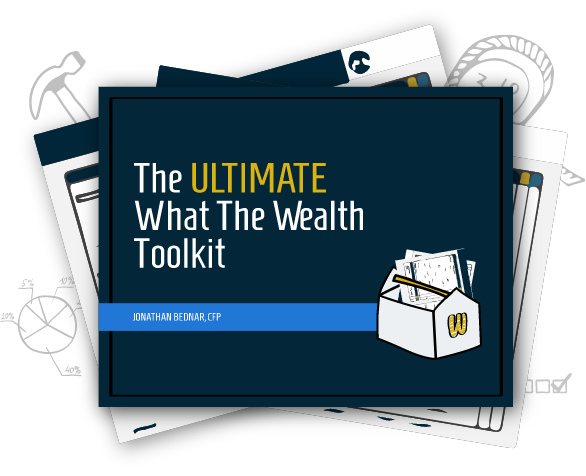Learning To Ride the Market Waves
Much of the advice I, or any good financial advisor gives is often easier said than done. And in no situation is that more true than during alarming market dips when we will tell you to sit tight and do nothing. Learning to ride market waves is easier said than done, but I’ve got some convincing evidence to show why you should, and a few tips to make it easier and possibly even profitable! Let’s start with discussing loss aversion.
Loss Aversion
Loss aversion is our tendency to prefer avoiding a loss to acquiring an equivalent gain. A study by Amos Tversky and Daniel Kahneman in 1991 showed that losses are twice as psychologically powerful as gains.
Put simply; we would be twice as upset if we lost $100 as we would feel happy if we found $100. And that’s probably true. Think of it this way. If you had $100 in your pocket and it fell out, you would really be angry with and kicking yourself. Maybe days and weeks later. And if you found $100 on the ground, you’d be tickled by your good luck but probably not think about it much beyond that day.
Loss aversion makes riding the waves during a down market hard. We hate to lose money on our investments and want to do something to stem the losses. Too often, we decide to sell. In a down market. This, of course, goes against Rule #1 of investing, “Buy low, sell high.”
And we know this; we’re all well aware. But loss aversion is so powerful it can compel us to make what we know is a bad decision.
25 Days
This is the best argument against loss aversion and basing investing decisions on emotion (the same thing essentially) that I’ve ever come across.
If you invested $1 million in an index that closely matches the S&P 500 in 1999 and let it ride through all of the market’s ups and downs, by the end of 2021 you would have $5.9 million. Nearly a 6x return on your initial investment. Let’s think of some of the catastrophes that impacted the market in those 20 years. This is not a comprehensive list, just what I came up with off the top of my head and not in order:
● The tech bubble burst
● 9/11
● The 2008 financial crisis
● Trade wars
● Brexit
● Ebola
● Zika
● Covid
A lot of spooky stuff in 20 years!
But if you missed out on the biggest 25 days of market gains in that 20 years, and it’s essential to remember the biggest gains often come very close to the biggest plunges, by pulling out of the market, your $1 million would only be worth $1.29 million! You would have lost out on $4.6 million in gains!
Recent News
Let’s look at a very recent event, February 24th, when Russia invaded Ukraine.
Upon that news, the Dow opened down 2-2.5%, and the Nasdaq was down 3%. But by the end of the day, things had rebounded somewhat. The Nasdaq was up 3.3%, and the Dow was up a quarter percent. Not great, but it was still a gain for the Dow. If you panic sold early in the day, you might have made a mistake that cost you 5-6% of your portfolio.
It’s not easy to do nothing in the face of bad news, but it is almost always the best decision. Don’t make any moves; just ride the wave.
Three Questions
When you’re getting spooked by bad financial news or bad world news that is going to negatively impact the market, return to your investment policy statement, which was created around three questions:
● Why are you investing?
● What are your core values?
● What are your dreams?
Reminding ourselves of the answers to these questions can help bolster our confidence that the investing decisions we made around these questions were the right ones at the time and are the right ones now, instead of focusing on avoiding a loss.
Roth Conversions
Every situation presents us with opportunities, even bad situations. A down market can be a good time to do a Roth conversion.
If you have money in a retirement account like an IRA or a 401k, when you withdraw that money, it will be taxed as ordinary income because you’ve not yet paid taxes on it. But if you don’t need to withdraw money from those accounts and we’re in a down market, you can convert depressed money from an IRA to a Roth IRA. Doing so means you’ll pay less in taxes on it because the account balance is down. The money will grow tax-free going forward, and you’re dealing with current tax brackets, not unknown future brackets, which could be higher.
A Roth Conversion during a down market is something to consider, but everyone’s circumstances are different, so it’s best to consult a professional before making any decisions.
Create the Life You Love
You can create the life you love, even in a lousy market. You just have to ride the wave!
Tune in as I share some interesting data on not only how market losses are felt psychologically to investors in loss aversion, but also the difference that a mere matter of days could make to the outcome of your investments. I also discuss how to ride the market waves with confidence, why sometimes the best course of action is to do nothing, and the planning strategy that you can use to turn a negative into a positive.
Listen to the Full Episode:
What You’ll Learn In Today’s Episode:
- How to shelter yourself from the pain of market loss.
- The difference that a day can make when it comes to the markets.
- Why sometimes it’s best to do nothing.
- How to stay grounded in your investment strategy.
- A planning strategy that could help shelter you from the ebbs and flows of the market.
Ideas Worth Sharing:
“It can be hard to see money that you’ve saved and diligently invested just seem to go down and down and down.” – Jonathan Bednar
“It’s not easy to just do nothing.” – Jonathan Bednar
“Some of the best days come after the worst days.” – Jonathan Bednar
Resources In Today’s Episode:
- Jonathan Bednar: Email | Twitter | LinkedIn
- What The Wealth?! by Jonathan Bednar
- Keep Calm and Remain Diversified
Enjoy the show? Use the Links Below to Subscribe:






